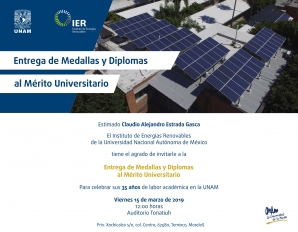Mostrando artículos por etiqueta: 2017 Memorias
Experimental analysis of a flat plate receiver for measurement of low thermal power of a central tower solar system
A Piña-Ortiz, JF Hinojosa, RA Perez-Enciso, VM Maytorena, C Estrada, CA Pérez-Rábago, RA Calleja
Abstract
In the city of Hermosillo, in the northwestern state of Sonora, México, the University of Sonora in agreement with the National Autonomous University of México is developing solar tower technology. A thermal receiver was designed to measure the thermal power of a small number of heliostats and experimental results were obtained to measure the thermal power of a small number of heliostats. The flat plate thermal receiver is a parallelepiped enclosure 1.20 m high, 1.23 m wide and 0.1 m deep with a receiving area of 1.476 m2 and a ε = 0.95, It also has 1228 cylindrical fins evenly distributed in the interior, each fin has a diameter of 0.0095 m and a length of 0.09 m, which increases the area of the receiving wall by up to 329%. Three experiments (with 1, 4 and 7 heliostats respectively) were carried out using the effect of the radiative flux provided on: the estimated thermal power, thermal efficiency, temperature distribution of the internal surface of the receiving wall (plate), the temperature distribution in the fins and in the fluid; all of this during steady state conditions. The experiments were performed for a Re⎯⎯⎯⎯ number of 2.90 × 104; it was found that the thermal efficiency of the system decreases as the radiative flux increases. The maximum efficiency was 84.9% and the minimum was 58.4% for experiment 1 and 3 respectively. We also observe that the temperature gradients of the fins increase as the radiative flux increases and that the fluid increases its temperature as it passes through the receiver and the center of the plate has the higher temperatures.
Thermal Behavior and Heat-Flux Distribution in a Solar Rotary Kiln
Alessandro Gallo, Héctor González-Camarillo, María Isabel Roldán, Elisa Alonso, Carlos Pérez-Rábago
Abstract
In this work, the first stage of a project devoted to the evaluation of rotary kilns as thermal receivers for industrialheat production was carried out. A small-scale rotary kiln was designed, installed and tested in the IER-UNAM’s solar furnace. In the experiment, the kiln was filled with 40 g of 2-mm diameter spherical particles and it rotated at 5 rpm. The thermal equilibrium was reached after almost 2 hours of operation and a temperature of 830 ºC was achieved. In order to evaluate the irradiance distribution on the kiln aperture, an indirect estimation method was adopted. The method consists in determining firstly the Solar Furnace Factor and the incident power, and then it is calibrated the image of the irradiance distribution on a Lambertian target placed at the furnace focus. This method does not require any measurement of the irradiance on the target plane. Once the irradiance distribution was calibrated, it was compared with a ray-tracing simulated irradiance of the same system at the selected position, obtaining a maximum average deviation of 2.8%. Furthermore, a parametric analysis of the internal wall absorptance and kiln position was carried out in order to evaluate the heat-flux distribution on the kiln walls. Finally, the irradiance on the kiln walls with and without the particle bed was estimated.
Thermal Behavior and Heat-Flux Distribution in a Solar Rotary Kiln
Isothermal and non-isothermal kinetics of metal oxide redox reactions performed in a solar furnace
Elisa Alonso and Carlos Pérez-Rábago
Abstract
Kinetic behavior of solar processes should be studied in solar facilities in order to consider the real heating conditions that affect the process. In this work, the thermo-desorption of CuO was performed in a solar reactor operated in a solar furnace. Kinetic of this process was studied considering both isothermal and non-isothermal methods. By means of isothermal methods, it was found that the reaction follows the Avrami-Erofeev equation and the kinetic parameters varied according to the n coefficient of such an equation. Master-plots method was then applied from non-isothermal experiments. The employed methodology was easier and the experimentation time much shorter than in isothermal case. The Avrami-Erofeev mechanism was clearly confirmed with this method.
Isothermal and non-isothermal kinetics of metal oxide redox reactions performed in a solar furnace
Potential of solar central tower systems for thermal applications in the production chain of copper by pyrometallurgical route
Irving Cruz-Robles, Alfonso J. Vázquez Vaamonde, Elisa Alonso, Carlos A. Pérez-Rábago, Claudio A. Estrada
Abstract
Copper is an indispensable input element in most economic sectors. However, its production chain has significant and adverse consequences on the environment. Through pyrometallurgical route it is estimated that each kilogram of refined copper consumes 33 MJ and generates a footprint of 3.3 kg of CO2. Primary production projections for 2019 amount to 26,500 kT, of which 79% will be by pyrometallurgical route. It is a responsibility of the industry to makes the process more environmental friendly. This can be done replacing the current energy matrix by the use of renewable energy. In this first and preliminary work we are evaluating the technical potential to integrate Central Tower Plants (CTP) into the smelting stage as a solar energy source. According to the mineral books and the irradiation maps, almost 20% of the current production can be match with these solar concentration systems because of the irradiance levels available where the metallurgical plants are located. The incorporation of a CTP in the world largest copper metallurgical facility to substitute the current fossil fuel energy supply could demand a capacity of 68 MWt. This last consideration obeys to the weighted average of the specific energy consumption gave by the Chilean Copper Commission COCHILCO. However, the results of this work indicate that the behavior of this change in the operative parameters could reduce the 68 MWt almost in a half.

